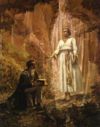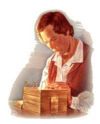Book of Mormon
The Book of Mormon: Another Testament of Jesus Christ[1] is one of the four standard works, or scriptures, of the Church of Jesus Christ of Latter-Day Saints (Mormons). The other standard works are the Bible, the Pearl of Great Price, and the Doctrine and Covenants.
Mormons believe that Joseph Smith, Jr. translated the Book of Mormon from a set of gold plates he received from an angel named Moroni[2]
“Joseph Smith would put the seer stone into a hat, and put his face in the hat, drawing it closely around his face to exclude the light; and in the darkness the spiritual light would shine. A piece of something resembling parchment would appear, and on that appeared the writing. One character at a time would appear, and under it was the interpretation in English. Brother Joseph would read off the English to Oliver Cowdery, who was his principal scribe, and when it was written down and repeated to Brother Joseph to see if it was correct, then it would disappear, and another character with the interpretation would appear. Thus the Book of Mormon was translated by the gift and power of God, and not by any power of man.” (David Whitmer, An Address to All Believers in Christ, Richmond, Mo.: n.p., 1887, p. 12.)
-Russell M. Nelson, “A Treasured Testament,” [3]
The Book of Mormon tells the story of the descendents of a man named Lehi, who took his family from Jerusalem to the Americas. According to the book, Lehi's wicked sons, Laman and Lemual, turned against his righteous sons, Nephi and Sam, and were cursed with dark skin[4]. Mormons believe that descendents of Lehi were the ancestors of some Native Americans; these people are referred to as "Lamanites" in the Book of Mormon:[5]
Nephi and Sam's descendents, the Nephites, eventually turned to wickedness and were destroyed by the more numerous Lamanites. One of the last Nephites, Moroni, buried the golden plates in what is now New York State to keep them from falling into the hands of the Lamanites and being destroyed.[6] Three Nephites were blessed with eternal life and still wander the Earth today serving others.[7]
A post-resurrection appearance in the New World by Jesus is also described in the Book of Mormon. In 1982, the subtitle, "Another Testament of Jesus Christ" was added to the title page[8].
Mormons and other Latter-Day Saints believe that the book is of ancient origin and that the personages and events described therein are factual. At the same time, Mormons deny that the book is to be considered inerrant. Its contents have been revised repeatedly by the Church authorities.
Contents
Historicity
The Book of Mormon: Another Testament of Jesus Christ is entirely unsupported by geography, archaeology, linguistics or genetics. Its introduction states that it is: "a volume of holy scripture comparable to the Bible." Even cursory examination shows this to be untenable. For example, the book of Jarom says in verse 8: "And we multiplied exceedingly, and spread upon the face of the land, and became exceedingly rich in "gold, and in silver, and in precious things, and in fine workmanship of wood, in buildings, and in machinery, and also in iron and copper, and brass and steel, making all manner of tools of every kind to till the ground, and weapons of war - yea, the sharp pointed arrow, and the quiver, and the dart, and the javelin, and all preparations for war."
Although extensive exploration has been performed by both Mormon and non-Mormon historians and archaeologists, no artifacts supporting this story have ever been unearthed. Native Americans did not use metal of any kind in their weaponry (which was primarily made from stones (such as obsidian) or wood). This is most obvious at Hill Cummorah in upstate New York (owned by the LDS church) where the Book of Mormon claims a battle took place where millions of people were killed. In this battle, spears, swords, chariots, armor and other preparations of war were purported to have been used. Although the LDS church owns the land where the battle is said to have taken place and the church has performed archaeological excavations there, not a single trace of the battle has ever been uncovered.
The cities named throughout the Book of Mormon include: Aaron, Ammonihah, Ani-Anti, Antiparah, Bountiful, City by the Sea, Cumeni, Desolation, Gid, Gideon, Jacob, Judea, Jordan, Josh, Kishkumen, Laman, Lehi, Lemuel, Manti, Melek, Mocum, Morianton, Moroni, Moronihah, Mulek, Nehor, Nephi, Nephihah, Noah, Omner, Onihah, Shilom, Shimnilom, Sidom, Teancum and Zarahemla as well as various other named lands and places. No traces of these cities have ever been found. Although LDS apologists have attempted to identify Mayan ruins such (as Palenque in Southern Mexico) as Book of Mormon cities, such attempts have failed. Accordingly, the Church of Jesus Christ of Latter Day Saints takes no official position on the geography of the Book of Mormon.
Further, none of the artifacts named throughout the Book of Mormon including buildings of cement, buildings covering the face of the land, elegant spacious buildings, cities, villages, thrones, temples, towers, vineyards, swords, spears, shields, chariots, machinery, breastplates, tools, iron, copper, brass, gold, silver, coins and metal plates (this list is not exhaustive) have ever been discovered in the Americas by any Mormon or non-Mormon archaeologists.
In recent years, genetic studies have proved that all native Americans (from north, central and south America) are in fact genetic descendants of populations in Asia, most specifically the region of Russia known as Siberia. This confirmed what was already believed by anthropologists (from studies of linguistics and archaeology) - that Siberians traveled approximately 50 miles across the Bering Straight (over a now-absent land-bridge, ice or by using watercraft) and populated the Americas - not over thousands of miles of ocean from Israel as the Book of Mormon purports.
Contents
The Book of Mormon: Another Testament of Jesus Christ [9] is divided up into many sections or parts, including a Title Page, Introduction, The Testimony of Three Witnesses, The Testimony of Eight Witnesses, the Testimony of the Prophet Joseph Smith, A Brief Explanation about The Book of Mormon, and the following main parts or divisions commonly referred to as "books," as in "The Book of Moroni," followed by the common abbreviation in parentheses:
- First Nephi (1 Ne.)
- Second Nephi (2 Ne.)
- Jacob (Jacob)
- Enos (Enos)
- Jarom (Jarom)
- Omni (Omni)
- Words of Mormon (W of M)
- Mosiah (Mosiah)
- Alma (Alma)
- Helaman (Hel.)
- Third Nephi (3 Ne.)
- Fourth Nephi (4 Ne.)
- Mormon (Morm.)
- Ether (Ether)
- Moroni (Moro.).
The first sentence of the Introduction is quite self-explanatory: "The Book of Mormon is a volume of holy scripture comparable to the Bible. It is a record of God’s dealings with the ancient inhabitants of the Americas and contains, as does the Bible, the fulness of the everlasting gospel." [10]
- Objects listed in the Book of Mormon
- People listed in the Book of Mormon
- Places listed in the Book of Mormon
Other denominations
The Book of Mormon is also accepted as Scripture by some breakaway denominations, the largest of which, the Community of Christ (est. 1860), publishes its own versions of the Book of Mormon, with different chapter and verse divisions, and one with "modernized" language. Most other Christian denominations, Catholic and Protestant, reject the Book of Mormon as Scripture.
Polygamy
It should be noted that although the Book of Mormon generally forbids polygamy, it allows for its practice when divinely mandated, apparently for the purpose of raising righteous posterity. The Book of Mormon says the following concerning plural marriage:
"Wherefore, my bretheren, hear me, and hearken to the word of the Lord: For there shall not any man among you have save it be one wife, and concubines he shall have none... For if I will, saith the Lord of Hosts, raise up seed unto me, I will command my people; otherwise they shall hearken unto these things." (Jacob 2:27,30).
The revelation that authorized the practice of polygamy among Latter-day Saints during the 19th Century is recorded in the Doctrine and Covenants, section 132.
Notes and references
- ↑ The Book of Mormon; Title page since 1982: The Book of Mormon: Another Testament of Jesus Christ. Original title page: The Book of Mormon: An Account Written by the Hand of Mormon upon Plates Taken from the Plates of Nephi.
- ↑ "History of Joseph Smith," History of the Church Vol. 1
- ↑ "A Treasured Testament," Ensign, July 1993, 61
- ↑ GospelDoctrine.com
- ↑ Elder Spencer W. Kimball of the Quorum of the Twelve Apostles
- ↑ The Book of Mormon
- ↑ "Clyde J. Williams on the Three Nephites and the Doctrine of Translation," Thoughts on Gospel Doctrine Lesson 42, Deseret Book.
- ↑ A Short Introduction to the Book of Mormon
- ↑ http://scriptures.lds.org/en/bm/contents
- ↑ http://scriptures.lds.org/en/bm/introduction
External Links
- The Book of Mormon - An online edition
- The Logical Arguments of the Book of Mormon, Kelly Bingham, November 1, 1997

